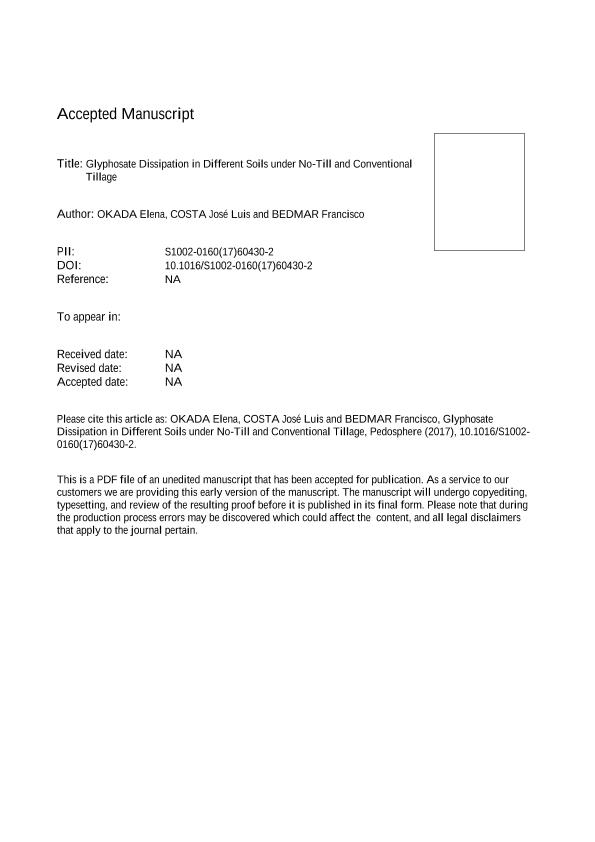Mostrar el registro sencillo del ítem
dc.contributor.author
Okada, Elena

dc.contributor.author
Costa, Jose Luis

dc.contributor.author
Bedmar, Francisco

dc.date.available
2019-06-12T19:04:21Z
dc.date.issued
2017-08-05
dc.identifier.citation
Okada, Elena; Costa, Jose Luis; Bedmar, Francisco; Glyphosate Dissipation in Different Soils under No-Till and Conventional Tillage; Science Press; Pedosphere; 5-8-2017; 1-19
dc.identifier.issn
1002-0160
dc.identifier.uri
http://hdl.handle.net/11336/78117
dc.description.abstract
Glyphosate is the most used herbicide in Argentina, accounting for 62% of the commercialized pesticides in the market. It is used as a weed controller in no-till systems, and it is also applied in various genetically modified crops (e.g. soybean, corn, cotton). Though it has a high solubility in water, it tends to adsorb and accumulate in agricultural soils. The main objectives of this work were to compare the dissipation of glyphosate and the accumulation of its metabolite aminomethylphosphonic acid (AMPA) over time in three soils from agricultural areas of Argentina, under long-term management of no-till (NT) and conventional tillage (CT) practices. Forty percent of the applied glyphosate was degraded within the first three days in all soils, indicating a fast initial dissipation rate. However, the dissipation rate considerably decreased over time and the degradation kinetics followed a two-compartment kinetic model. No differences were found between tillage practices. Dissipation was not related to the microbial activity measured as soil respiration. The fast decrease in the concentration of glyphosate at the beginning of the dissipation study was not reflected in an increase on the concentration of AMPA. The estimated half-lives for glyphosate ranged between 9 and 38 days. However, glyphosate bioavailability decreases over time as it is strongly adsorbed to the soil matrix. This increases its residence time which may lead to its accumulation in agricultural soils.
dc.format
application/pdf
dc.language.iso
eng
dc.publisher
Science Press

dc.rights
info:eu-repo/semantics/openAccess
dc.rights.uri
https://creativecommons.org/licenses/by-nc-sa/2.5/ar/
dc.subject
Dissipation
dc.subject
Pesticide
dc.subject
Two-Compartment Kinetic Model
dc.subject.classification
Meteorología y Ciencias Atmosféricas

dc.subject.classification
Ciencias de la Tierra y relacionadas con el Medio Ambiente

dc.subject.classification
CIENCIAS NATURALES Y EXACTAS

dc.title
Glyphosate Dissipation in Different Soils under No-Till and Conventional Tillage
dc.type
info:eu-repo/semantics/article
dc.type
info:ar-repo/semantics/artículo
dc.type
info:eu-repo/semantics/publishedVersion
dc.date.updated
2019-05-15T16:48:38Z
dc.journal.pagination
1-19
dc.journal.pais
China

dc.journal.ciudad
Marrickville NSW
dc.description.fil
Fil: Okada, Elena. Consejo Nacional de Investigaciones Científicas y Técnicas. Centro Científico Tecnológico Conicet - Mar del Plata; Argentina. Instituto Nacional de Tecnología Agropecuaria. Centro Regional Buenos Aires Sur. Estación Experimental Agropecuaria Balcarce; Argentina
dc.description.fil
Fil: Costa, Jose Luis. Instituto Nacional de Tecnología Agropecuaria. Centro Regional Buenos Aires Sur. Estación Experimental Agropecuaria Balcarce; Argentina
dc.description.fil
Fil: Bedmar, Francisco. Universidad Nacional de Mar del Plata. Facultad de Ciencias Agrarias. Departamento de Producción Vegetal; Argentina
dc.journal.title
Pedosphere

dc.relation.alternativeid
info:eu-repo/semantics/altIdentifier/doi/http://dx.doi.org/10.1016/S1002-0160(17)60430-2
dc.relation.alternativeid
info:eu-repo/semantics/altIdentifier/url/https://www.sciencedirect.com/science/article/pii/S1002016017604302
Archivos asociados
